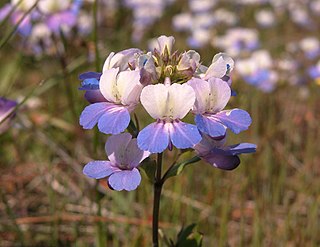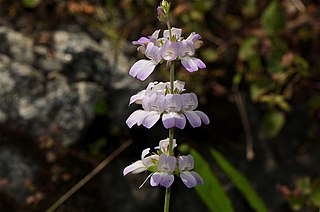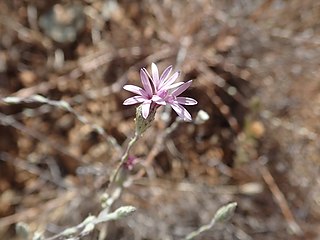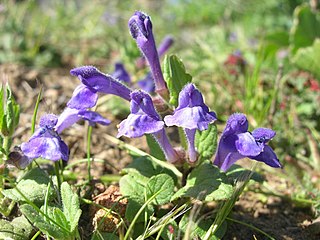
Lepechinia fragrans is a flowering herbaceous shrub known by the common names island pitchersage and fragrant pitchersage. It is a member of the Lamiaceae, or mint family, but like other Lepechinia, the flowers are borne in racemes instead of in mintlike whorls.

Collinsia grandiflora is a species of flowering plant in the plantain family known by the common names giant blue eyed Mary and large-flowered collinsia. This wildflower is native to western North America from British Columbia to northern California where it grows in coniferous understory and woodland.

Collinsia parviflora is a species of flowering plant in the family Plantaginaceae known by the common names maiden blue eyed Mary and small-flowered collinsia.

Collinsia parryi is a species of flowering plant in the plantain family known by the common name Parry's blue eyed Mary. It is endemic to central and southern California, where it is found in the southern Coast Ranges and in the Transverse Ranges north and east of Los Angeles.

Collinsia bartsiifolia is a species of flowering plant in the plantain family known by the common name white blue-eyed Mary.

Collinsia callosa is a species of flowering plant in the plantain family known by the common name desert mountain blue-eyed Mary. It is endemic to California, where it grows in the mountains of the southernmost Sierra Nevada, the Transverse Ranges, and the mountains of the Mojave Desert region. It grows in desert scrub, chaparral, and woodland habitat on the mountain slopes.

Collinsia childii is a species of flowering plant in the plantain family known by the common name Child's blue-eyed Mary.

Collinsia concolor is a species of flowering plant in the plantain family known by the common name Chinese houses.
Collinsia corymbosa is a species of flowering plant in the plantain family known by the common name round-headed Chinese houses. It is endemic to the coastline of California north of the San Francisco Bay Area, where it is uncommon and scattered. Its habitat is the sand dunes of the immediate coastline. This is an annual herb producing a scaly, hairy, red to reddish green stem which grows upright or decumbent to a maximum length of about 25 centimeters. The thick, sparsely hairy leaves are rippled and lobed along the edges, which may be somewhat turned under. The inflorescence is a dense whorl of several distinctive flowers. Each has a hairy calyx of lobed reddish sepals and a corolla up to about 2 centimeters long. The flower has two small upper lobes and three longer lower lobes which come together in a nearly tubular shape. It is generally white with a light purple tint. The smaller upper lobes curl back and dry to brown at their lips.
Collinsia greenei is a species of flowering plant in the plantain family known by the common name Greene's blue-eyed Mary.
Collinsia linearis is a species of flowering plant in the plantain family known by the common name narrowleaf blue-eyed Mary.

Collinsia sparsiflora is a flowering plant in the family Plantaginaceae known by the common names spinster's blue-eyed Mary and few-flowered collinsia. One variety of the species is native to the West Coast of the United States as far north as Washington, while the other three varieties are limited to California alone.

Collinsia torreyi is a species of flowering plant in the plantain family known by the common name Torrey's blue-eyed Mary. It is native to California and adjacent sections of Oregon and Nevada, where it grows in the coniferous forests of several mountain ranges, including the Sierra Nevada.

Lessingia hololeuca is a species of flowering plant in the family Asteraceae known by the common name woollyhead lessingia.

Nemacladus glanduliferus is a species of flowering plant in the bellflower family known by the common name glandular threadplant. It is native to the southwestern United States and Baja California, where it grows in desert and plateau habitat. It is an annual herb producing a purplish or brownish green, branching stem up to about 25 centimeters tall. Small oval leaves occur at the base of the plant. The inflorescence is a series of zigzagging branches bearing occasional flowers on thin, erect pedicels. There is a single small bract at the base of each pedicel. The flower at the curved tip of the pedicel is just a few millimeters wide. There are five pointed sepals and five white corolla lobes, generally three in the upper lip and two in the lower.
Nemacladus interior is a species of flowering plant in the bellflower family known by the common name Sierra threadplant. It is native to the Sierra Nevada of California, and it is known from Oregon as well. It grows in mountain forest habitat. It is an annual herb producing a stiff upright purple-brown stem up to about 25 centimeters tall. Small toothed oval leaves 1 to 2 centimeters long occur at the base of the plant. The inflorescence is a zigzagging series of branches bearing occasional flowers on thin pedicels. There is a single tiny bract at the base of each pedicel. The flower is a few millimeters long. It has five triangular sepals and five corolla lobes, three lobes on the upper lip and two on the lower. The corolla is white to pale purple or pink with a thin red band and yellow spot at the base of each lobe.

Pedicularis centranthera is a species of flowering plant in the family Orobanchaceae known by the common names dwarf lousewort and Great Basin lousewort. It is native to the western United States from eastern Oregon and California to Colorado and New Mexico, where it grows in sagebrush and other basin and plateau habitat. It is a perennial herb producing several short stems a few centimeters tall from a basal caudex. The leaves are up to 20 centimeters long, lance-shaped and divided into many overlapping toothed, wrinkled, or fringed lobes. The inflorescence is a short raceme bearing many long, protruding, club-shaped flowers. Each flower may exceed 4 centimeters in length and is white or pale purple with dark purple tips on the wide ends of its upper and lower lips. The sepals of the flowers are shorter and hairy. The fruit is a capsule around centimeter long containing seeds with netlike surfaces.

Scutellaria tuberosa is a species of flowering plant in the mint family known by the common name Danny's skullcap. It is native to western North America from Oregon through California to Baja California, where it is widespread throughout the mountain and coastal regions; it is absent from the deserts and the Central Valley of California. It can be found in forest and woodland habitat, and a variety of open habitat types, often appearing in areas recently cleared by wildfire. It is a perennial herb producing an erect stem or cluster of stems up to about 25 centimeters tall from a root system with tubers. The stems are coated in short, spreading hairs. The oval leaves are oppositely arranged. The lowest leaves are borne on short petioles. Flowers emerge from the leaf axils. Each flower is held in a calyx of sepals with a large ridge or dome-shaped appendage on the upper part. The tubular corolla is one to two centimeters long and has a large upper and lower lip. The upper lip is folded into a beaklike protrusion and the lower has three wide lobes. The corolla is deep purple-blue, usually with a white patch or mottling on the lower lip.

Triphysaria floribunda is a rare species of flowering plant in the family Orobanchaceae known by the common name San Francisco owl's-clover. It is endemic to California, where it is known only from the San Francisco Bay Area. It is limited to coastal regions of Marin, San Francisco, and San Mateo Counties, where it occurs in coastal prairie habitats, sometimes on serpentine soils.

Veronica anagallis-aquatica is a species of flowering plant in the family Plantaginaceae known by the common names water speedwell, blue water-speedwell,brook pimpernel, and sessile water-speedwell. It is also listed as Veronica catenata. Its true native range is not clear, but the plant is present on most continents, and in most places it is probably naturalized. It occurs in many types of moist and wet habitat, and it is semi-aquatic, often growing in shallow water along streambanks, in ponds, and in other wetland environments. It is a rhizomatous perennial herb with stems growing 10 centimeters to about a meter in maximum length. It may be decumbent, the stem spreading along the ground and rooting where it touches moist substrate, or erect in form. The oppositely arranged leaves are green, smooth-edged or toothed, and sometimes clasping the stem where the leaf pairs meet at the bases. The inflorescence is a raceme of many flowers arising from the leaf axils. Each flower is borne on a short, curving pedicel. The flower corolla is up to a centimeter wide with four lobes, the upper lobe being widest. It is blue, lavender, or violet with purple lines near the base of each lobe. At the center are two small protruding stamens.

















